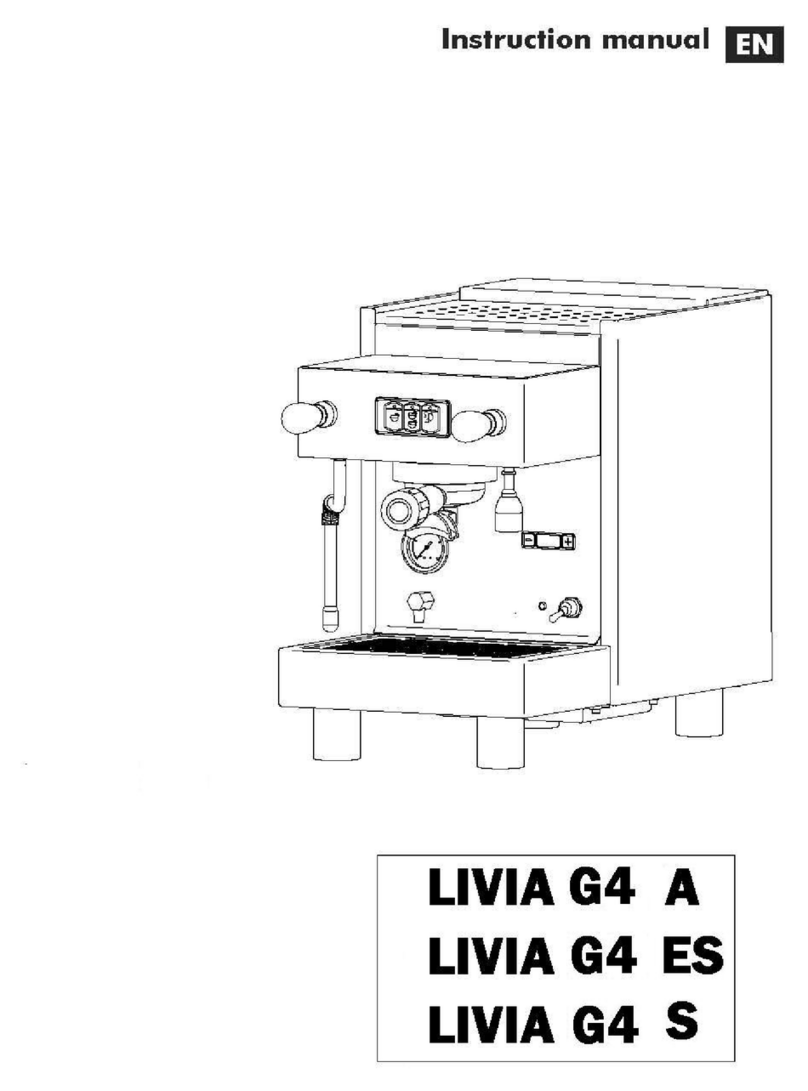ter and prepare tea, camomile tea and other infu-
sions, produce steam and heat drinks (milk, hot
chocolate, cappuccino, punch etc.).
This machine was designed only and exclusively
for the uses as above.
All other uses must be considered improper and
therefore forbidden by the manufacturer. The
manufacturer cannot be held responsible for dam-
age caused by the improper use of the espresso
coffee machine.
2 - TRANSPORT
2.1 Packing
The LIVIA G4 espresso coffee machine is wrapped
in polyurethane foam and then packed in card-
board boxes.
Warnings:
- After removing the machine from the packing,
check that it is whole and make sure that it has
all fittings.
- Packing materials must not be left within chil-
dren’s reach and must be disposed of at the
correct dumps.
- If the machine is found to be damaged or some
parts are missing, do not use the machine and
inform the local dealer immediately.
2.2 Moving the machine
The espresso coffee machine can be moved using
a forklift truck, transport pallets or manually.
2.3 Storage
The correctly packed machine must be stored in
a dry environment, within a temperature range
of +5°C to +30°C and with relative humidity of
maximum 70%.
A maximum of four boxes can be piled on top of
one another.
1 - WARNINGS
1.1 General warnings
- The electrical and plumbing systems must be
prepared by the user according to the indica-
tions provided in chapter 4 of this “Machine
Installation” booklet.
- The installer cannot modify the pre-existing
plant created by the user in any case.
- This instruction booklet is a full part of the ma-
chine and must be read carefully by the user
before starting up the machine itself.
- Keep the booklet for future reference.
- The machine is delivered without water in the
boiler in order to avoid any possible damage
caused by frost.
- Prepare the earthing of the electrical plant.
- Do not touch the machine with damp and/or
wet hands and feet.
- Do not use the machine in bare feet.
- Do not connect the electrical power cable to
loose extensions or similar.
- Do not disconnect the machine from the elec-
trical power by pulling the electrical power ca-
ble.
- Do not turn on the machine while the electrical
power cable is coiled.
- This appliance is not intended for use by per-
sons (including children) with reduced physical,
sensory or mental capabilities, or lack of expe-
rience and knowledge, unless they have been
given supervision or instruction concerning use
of the appliance by a person responsible for
their safety.
- Do not allow untrained staff and/or children to
use the machine.
- To prevent water from leaking in the machine,
place cups on the cup heater with the hollow
part facing upwards.
- The following symbol indicates the danger of
burns.
1.2 Foreseen use
The LIVIA G4 espresso coffee machine was de-
signed to make espresso coffee, produce hot wa-






























